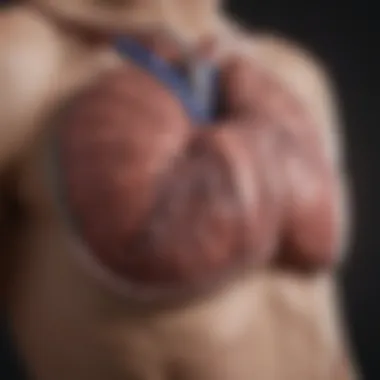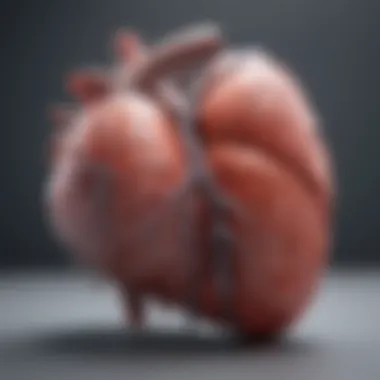Treatment Strategies for Right Ventricular Failure


Intro
Right ventricular failure is a complex medical condition that requires careful consideration and management. Understanding the treatment options available is crucial for healthcare professionals engaged in cardiovascular care. This condition occurs when the right ventricle cannot pump sufficient blood to the lungs, often leading to significant clinical complications. The purpose of this article is to offer a detailed analysis of both conventional and innovative treatment methodologies for right ventricular failure. Here, we delve into their mechanisms, indications, and efficacy through a rigorous review of recent research.
Methodology
Study Design
This analysis employs a systematic review approach. We examined a variety of studies, including clinical trials, observational studies, and meta-analyses, published within the last ten years. This design allows for a comprehensive evaluation of treatment options while considering a wide range of patient demographics and clinical settings. By combining findings from diverse sources, we aim to present a balanced perspective on the management of right ventricular failure.
Data Collection Techniques
Data were sourced from peer-reviewed journals, clinical databases, and national guidelines. Key searches utilized terms such as "right ventricular failure treatment," "pulmonary hypertension therapies," and "mechanical support devices." Academic databases such as PubMed and Scopus served as primary repositories for relevant literature. In addition, we reviewed data from the American College of Cardiology and other reputable cardiology societies to gather consensus statements and treatment guidelines.
Discussion
Interpretation of Results
The comprehensive review unveiled multiple effective treatment modalities for right ventricular failure, including pharmacotherapy, device-based interventions, and surgical options. Common pharmacological treatments like diuretics, vasodilators, and phosphodiesterase-5 inhibitors are frequently employed to alleviate symptoms and improve cardiac function. Moreover, devices such as right ventricular assist devices (RVADs) are gaining traction in clinical practice, showcasing promising outcomes in terms of survival and quality of life.
Limitations of the Study
While this review elucidates several treatment strategies, it is not without limitations. The heterogeneity of studies, particularly those relating to patient populations and treatment protocols, may introduce variability in outcomes. Additionally, many emerging therapies are still in the phase of investigation, which limits their generalizability. The diversity of approaches means that any single treatment may not apply uniformly across all patients.
Future Research Directions
There is a pressing need for further studies that focus on long-term outcomes of both established and novel therapies for right ventricular failure. Randomized controlled trials that compare emerging therapies directly with standard treatments would provide valuable insights. Additionally, investigations exploring the effects of personalized medicine in managing this condition should be prioritized.
Understanding Right Ventricular Failure
Right ventricular failure is a complex condition that significantly impacts cardiovascular health. Understanding it is crucial for several reasons. This condition can emerge from various underlying issues, such as chronic lung disease, heart attacks, and congenital heart defects. These factors deeply affect prognosis and treatment approaches.
Definition and Pathophysiology
Right ventricular failure occurs when the right ventricle is unable to pump effectively, disrupting blood flow to the lungs. This inefficiency leads to increased pressure in the heart and lungs. The underlying mechanism often involves structural or functional impairment of the ventricle. As the heart struggles to perform, symptoms manifest, which can complicate patient management.
Key elements to consider include:
- Impaired myocardial contractility leads to reduced output.
- Elevated pressures in the pulmonary circulation can result in pulmonary hypertension.
- Additionally, underlying conditions like left heart failure can exacerbate the situation.
Epidemiology and Risk Factors
Epidemiological data shows growing prevalence of right ventricular failure globally. Certain risk factors increase vulnerability and should be identified early. These include:
- Chronic Obstructive Pulmonary Disease (COPD): This condition can directly cause right ventricular failure due to hypoxia.
- Congenital Heart Disease: Patients with structural defects often have an adversely affected right ventricle.
- Myocardial Infarction: Damage to the heart muscle can impair right ventricular function.
Certain demographics are at a higher risk, particularly older adults and those with co-morbid conditions like obesity and diabetes. Prevention strategies must focus on managing these risk factors effectively.
Symptoms and Clinical Presentation
Symptoms of right ventricular failure can be non-specific and often overlap with other conditions, leading to challenges in diagnosis. Common signs include:
- Dyspnea: Shortness of breath during activity or even at rest.
- Fatigue: Patients may experience significant exhaustion with minimal effort.
- Peripheral Edema: Swelling in the legs and abdomen may indicate fluid retention due to heart dysfunction.
- Jugular Venous Distention: This sign indicates elevated central venous pressure.
Understanding these symptoms is vital for timely diagnosis and appropriate management. Clinicians should perform careful assessments to differentiate between right ventricular failure and other potential heart conditions.
"Awareness of symptoms can lead to earlier intervention, potentially improving outcomes in patients with right ventricular failure."
Diagnostic Approaches
In the context of right ventricular failure, diagnostic approaches are crucial for the identification and management of this complex condition. Selecting appropriate diagnostic methods is vital not only for confirming the diagnosis but also for understanding the underlying causes and determining the most effective treatment strategies. This section will focus on three principal modalities: clinical evaluation, imaging techniques, and laboratory tests. Each plays a distinct role in comprehensively assessing right ventricular function and guiding therapeutic decisions.
Clinical Evaluation
Clinical evaluation is often the first step in diagnosing right ventricular failure. Health care providers typically conduct a thorough history and physical examination. Key symptoms may include dyspnea, fatigue, and edema, which can indicate the heart's impaired ability to pump effectively. Providers often assess for signs of right ventricular dysfunction, such as jugular venous distension and peripheral edema.


Recognizing these clinical indicators allows for timely intervention and helps tailor therapy to individual patient needs. However, clinical evaluation has its limitations due to variability in presentation and overlap with other conditions. Consequently, it is often supplemented by other diagnostic techniques.
Imaging Techniques
Imaging techniques serve as an essential component in the assessment of right ventricular failure. They allow for visualization of cardiac structures and can offer detailed insights into the functioning of the right ventricle. Particularly, echocardiography, CT, and MRI are widely utilized, each providing unique advantages and insights.
Echocardiography
Echocardiography is a non-invasive imaging modality that plays a pivotal role in evaluating right ventricular function. It uses ultrasound waves to create images of the heart, allowing clinicians to visualize the chambers and assess their movement. One of the key characteristics of echocardiography is its ability to measure right ventricular size and function in real time.
The unique feature of echocardiography is its high accessibility and versatility. It can be performed at the bedside and does not involve radiation exposure. However, it relies heavily on operator skill, which could affect image quality and accuracy in certain cases.
CT and MRI
CT and MRI provide additional avenues for detailed cardiac imaging. These techniques are especially beneficial for specific scenarios such as evaluating complex congenital heart disease or assessing myocardial tissue characteristics.
A significant aspect of both CT and MRI is their capability to provide high-resolution images and assess heart diseases with remarkable detail. They are particularly beneficial for visualizing the right ventricle in three dimensions, allowing for better assessment of structure and function. That being said, both modalities involve certain disadvantages, such as increased costs and the requirement for patients to remain still for extended periods. Additionally, exposure to radiation in CT scans could be a concern.
Laboratory Tests
Laboratory tests complement imaging techniques and clinical evaluation by providing biochemical insights. Blood tests can help identify underlying conditions contributing to right ventricular failure, including cardiac biomarkers, electrolytes, and renal function tests.
BNP (B-type Natriuretic Peptide) levels, for instance, are often elevated in cases of heart failure and can be a valuable tool for the diagnostic process. When interpreted in conjunction with clinical findings and imaging data, laboratory tests enhance the overall diagnostic accuracy.
In summary, diagnostic approaches reinforce the assessment of right ventricular failure from multiple angles. Each technique brings its strengths and limitations, and an integrated strategy often yields the best outcomes. This multi-faceted approach sets the stage for the subsequent management and treatment of patients.
Standard Treatment Modalities
Standard treatment modalities for right ventricular failure are crucial for improving patient outcomes. These treatments can address the underlining dysfunction and help manage symptoms. Different approaches are available, ranging from pharmacological therapies to surgical interventions. They offer the opportunity to enhance the patient's quality of life and longevity. Key considerations include the patient's overall health, stage of the disease, and presence of co-morbid conditions.
Pharmacological Interventions
Pharmacological interventions play a significant role in managing right ventricular failure. They are designed to optimize hemodynamics and alleviate symptoms.
Diuretics
Diuretics are essential for managing fluid overload, a common symptom in right ventricular failure. They promote the excretion of sodium and water through kidneys, which helps reduce congestion.
Key characteristic: Their rapid onset of action enables immediate relief from symptoms.
Benefits: Diuretics such as furosemide are frequently used because they are effective in reducing edema and pulmonary congestion. However, excessive use can lead to electrolyte imbalances, necessitating careful monitoring.
Vasodilators
Vasodilators assist in lowering systemic vascular resistance, which reduces the workload on the heart. By relaxing blood vessels, they allow the right ventricle to pump more effectively.
Key characteristic: They can improve cardiac output without necessarily increasing heart rate.
Benefits: Initiating vasodilators like nitroglycerin may help some patients feel better quickly. However, side effects such as hypotension must be managed carefully.
Inotropes
Inotropes are specialized medications that enhance myocardial contractility. They are particularly crucial in acute settings where cardiac output is severely compromised.
Key characteristic: Increased contractility can support vital organ perfusion.
Benefits: Drugs such as dobutamine are beneficial in providing short-term support during acute decompensation. The downside includes risks of arrhythmias and should be used judiciously.
Device Therapy
Device therapy has emerged as a pivotal treatment option for patients with advanced right ventricular failure who do not respond adequately to pharmacotherapy.
Implantable Cardioverter-Defibrillators
Implantable cardioverter-defibrillators (ICDs) are critical for patients at risk of life-threatening arrhythmias. They monitor heart rhythms and deliver a shock if a dangerous rhythm occurs.


Key characteristic: Their primary role is to prevent sudden cardiac death.
Benefits: They significantly improve survival rates in appropriate patient populations. In some cases, patients may experience anxiety about device implantation and the possibility of discomfort with shocks.
Cardiac Resynchronization Therapy
Cardiac resynchronization therapy (CRT) aims to improve the timing of ventricular contractions. It is particularly effective in patients with a progression of heart failure symptoms.
Key characteristic: CRT uses a specialized pacemaker to synchronize contractions, improving cardiac performance.
Benefits: This therapy has been associated with improved functional capacity and reduced hospitalization rates. Yet, patient selection is crucial as not all patients will benefit.
Surgical Options
Surgical options are often considered for patients with structural problems contributing to right ventricular failure. These interventions can provide definitive solutions that are not possible through pharmacotherapy alone.
Valvular Repair or Replacement
Valvular repair or replacement is often needed when valvular heart disease contributes significantly to right ventricular dysfunction. Repairing defective valves can restore normal function and hemodynamics.
Key characteristic: Favorable outcomes can be achieved if the procedure is done timely.
Benefits: Repair tends to present fewer complications than replacement. However, the success of the surgery depends greatly on the underlying valve disease and patient health.
Heart Transplantation
Heart transplantation may be appropriate for select individuals with end-stage heart failure who do not respond to other treatments.
Key characteristic: It offers the possibility of extending life significantly in selected patients.
Benefits: Transplantation can radically improve the quality of life and functional status. However, complications such as organ rejection and the need for lifelong immunosuppression are critical considerations.
Understanding the different standard treatment modalities provides patients and healthcare providers with various options. Each modality must be evaluated within the context of the individual patient's needs and medical status.
Emerging Therapies
Emerging therapies in the realm of right ventricular failure represent a significant advance over traditional treatment options. These innovative approaches aim to address the underlying pathophysiology of the condition in new and exciting ways. The importance of exploring these therapies lies not only in their potential to improve patient outcomes but also in expanding the options available to healthcare professionals managing this complex condition. As traditional methods sometimes yield limited effectiveness, emerging therapies can offer fresh perspectives and treatment modalities that cater to individual patient needs.
Gene Therapy Approaches
Gene therapy represents a novel form of treatment aiming at correcting or modifying the underlying genetic factors contributing to right ventricular failure. This therapeutic strategy holds promise due to its potential to directly address defects at the molecular level. Genetic alterations can influence cardiac function and improve the performance of the right ventricle. For instance, targeted gene delivery systems can enhance the expression of proteins that aid in myocardial contractility and remodeling.
Research continues to reveal that gene therapy can lead to long-term improvements in cardiac health, providing hope to many patients who have exhausted conventional treatment options.
Stem Cell Therapy
Stem cell therapy is another promising avenue showing potential in treating right ventricular failure. This approach involves the use of pluripotent stem cells or adult stem cells, which have the ability to differentiate into various cell types, including cardiac cells. By administering stem cells into the cardiac tissue, there is potential for regeneration and repair of damaged myocardium. Clinical studies are underway to assess how effectively these stem cells can improve heart function and overall patient quality of life.
Novel Pharmacological Agents
Novel pharmacological agents are crucial in the developing landscape of treatments for right ventricular failure. These medications often target specific pathways in the body that play a pivotal role in cardiac function.
Angiotensin Receptor-Neprilysin Inhibitors
Angiotensin receptor-neprilysin inhibitors, such as sacubitril/valsartan, have gained attention due to their beneficial effects on heart failure management. These agents simultaneously inhibit the effects of angiotensin II while enhancing the action of natriuretic peptides, leading to vasodilation and natriuresis. This dual action results in reduced cardiac workload and improved hemodynamics, proving advantageous for patients with right ventricular failure.
Key characteristics of this therapeutic class include their ability to lower blood pressure and decrease hospitalizations due to heart failure exacerbations. However, their unique feature of balancing two opposing systems can also lead to adverse effects, necessitating careful monitoring during treatment.
SGLT2 Inhibitors
SGLT2 inhibitors, such as empagliflozin and dapagliflozin, have emerged as a pivotal class of medications in the treatment of heart failure, including right ventricular failure. They primarily work by inhibiting glucose reabsorption in the kidneys, leading to increased glucose and sodium excretion. This mechanism translates into benefits such as reduced cardiac preload and afterload, contributing positively to right ventricular function.
Noteworthy is their characteristic of improving renal function and their ability to decrease the risk of cardiovascular death. However, potential side effects include urinary tract infections and dehydration concerns, which should be considered in clinical decision-making.
Management of Co-Morbid Conditions


Management of co-morbid conditions is essential in treating right ventricular failure effectively. This multifaceted approach addresses various conditions that often coexist with cardiovascular diseases. By managing these co-morbidities, healthcare professionals can enhance patient outcomes and quality of life, ultimately leading to better management of right ventricular failure itself.
It is crucial to recognize that conditions such as Chronic Obstructive Pulmonary Disease (COPD), obesity, and diabetes significantly impact the heart's functioning. These disorders can exacerbate symptoms and increase the risk of complications. A comprehensive management strategy focuses on the interplay between these conditions and right ventricular failure, thus ensuring a holistic approach to patient care.
Chronic Obstructive Pulmonary Disease (COPD)
Chronic Obstructive Pulmonary Disease (COPD) is a significant risk factor for patients with right ventricular failure. The link between these two conditions is often due to the increase in right ventricular workload imposed by increased pulmonary artery pressure. The usual cause comes from prolonged hypoxia and subsequent pulmonary hypertension, which can lead to cor pulmonale, a form of right heart failure.
Managing COPD involves a combination of pharmacological therapies, including bronchodilators, corticosteroids, and, in some cases, oxygen therapy. Regular pulmonary rehabilitation can also provide patients with tools to manage their breathing and improve exercise capacity. These interventions aim to reduce symptoms and improve overall lung function, which, in turn, may alleviate some of the burden on the right ventricle.
Obesity and Metabolic Disorders
Obesity is another crucial factor impacting right ventricular function. Excess body weight contributes to increased systemic vascular resistance and can promote the development of right ventricular hypertrophy. The presence of metabolic disorders, such as metabolic syndrome, can complicate this relationship.
A weight management program is often necessary for patients suffering from both obesity and right ventricular failure. This program typically incorporates dietary changes, physical activity, and, when appropriate, pharmacotherapy or bariatric surgery. These measures can lead to improvements in cardiac function and overall health. Better weight regulation can also contribute to enhanced quality of life for patients.
Diabetes Management
Diabetes plays a critical role in heart disease, including right ventricular failure. Patients with diabetes typically experience more severe cardiovascular conditions. This is due in part to the effects of hyperglycemia and insulin resistance on vascular health and the heart muscle itself.
Effective diabetes management is vital for reducing the risk of cardiovascular complications. This can include lifestyle modifications focused on diet and exercise, alongside pharmacological treatments that control blood sugar levels. By achieving better glycemic control, patients can help mitigate some of the deleterious effects diabetes has on their cardiac function, which is especially important in the context of right ventricular failure.
Effective management of co-morbid conditions not only aids in controlling right ventricular failure but also enhances overall patient well-being and health outcomes.
Patient-Centric Care
In the context of right ventricular failure, patient-centric care represents a paradigm shift towards understanding and prioritizing the values, needs, and preferences of the individual patient. It contrasts with traditional models that often emphasize clinical measures over patient experience. This approach is particularly crucial given the complexity of right ventricular failure, which often overlaps with multiple comorbidities, including heart disease and respiratory conditions.
By focusing on patient-centric care, healthcare providers can tailor interventions that align more closely with the patient's lifestyle and expectations. It facilitates improved communication between healthcare teams and patients and encourages shared decision-making. Patients are empowered to take an active role in their treatment plans, which can lead to higher satisfaction levels and better adherence to therapeutic regimens.
Current evidence suggests that when patients feel heard and involved, their health outcomes can improve. Not only does this foster trust, but it also helps in understanding the full scope of a patient's condition, allowing for a more holistic approach to their treatment.
Role of Palliative Care
Palliative care plays a vital role in managing right ventricular failure, particularly in cases where the disease progression leads to advanced stages. It focuses on providing relief from symptoms and improving the quality of life for patients. Palliative care is not limited to end-of-life scenarios; rather, it can be integrated at any point in the disease process.
Key benefits of palliative care include:
- Symptom management: Addressing physical discomfort associated with heart failure, such as shortness of breath or fatigue.
- Emotional support: Offering psychological assistance to manage anxiety and depression that often accompany chronic illnesses.
- Family support: Helping families understand the patient's condition and involving them in care decisions.
Effective palliative care involves a multidisciplinary team, ensuring comprehensive assistance to the patient and their families. It is a crucial component of patient-centric care, aligning treatment with the patient’s goals and preferences.
Patient Education and Self-Management
Educating patients about right ventricular failure is essential for self-management. Knowledge empowers patients to recognize symptoms, understand medication regimens, and adhere to lifestyle modifications. This educational component should cover:
- Understanding the condition: Patients should know what right ventricular failure entails. This includes recognizing triggers for their symptoms and the importance of monitoring their status.
- Medications: Patients must be informed about each medication they take, its purpose, potential side effects, and signs of complications. Understanding these details fosters safer medication management.
- Lifestyle changes: Educating patients about the impact of diet, physical activity, and smoking cessation can significantly influence their health outcomes.
Self-management strategies encourage patients to take active roles in their health care. Simple practices like keeping a daily journal of symptoms, noting potential triggers, or employing relaxation techniques can make a substantial difference in managing their condition. Overall, effective patient education and self-management are essential cornerstones of patient-centric care in right ventricular failure, leading to better health outcomes.
Future Directions in Research
The realm of right ventricular failure is evolving, and understanding future directions in research is crucial for enhancing patient outcomes. Continued exploration in this area can unearthe new insights that may reshape treatment methodologies, opening avenues for innovative therapies. The importance of researching future directions is underscored by the need to address the limitations of current therapies and provide optimized management strategies.
The focus on research is critical because it not only amplifies knowledge but also cultivates a better understanding of the condition’s underlying mechanisms. Research initiatives are poised to identify novel biomarkers and therapeutic targets, which could streamline diagnosis and personalize treatment plans. There exists a potential to markedly improve the prognosis for those suffering from right ventricular failure through ongoing studies.
Clinical Trials and Studies
Clinical trials play a pivotal role in advancing treatment options for right ventricular failure. These studies assess the safety and efficacy of new drugs and interventions, providing valuable data that can guide clinical practice. They allow for systematic evaluation of emerging therapies, ensuring they hold promise before becoming part of standard care. A noteworthy aspect of clinical trials is their capacity to include diverse populations. This inclusion is essential for generating findings that reflect the variety of individuals who may experience right ventricular failure, thus enhancing the external validity of the results.
Research must continue to prioritize collaboration among multidisciplinary teams. Tailoring studies to focus on the intersection of various health disciplines could yield comprehensive insights that specifically address comorbidities commonly associated with right ventricular failure, such as pulmonary hypertension and obesity. By doing so, we can better understand how to effectively treat patients with complex health needs.
Advancements in Technology
Advancements in technology represent an essential frontier in the management of right ventricular failure. New imaging modalities, like advanced echocardiographic techniques, have enabled clinicians to visualize cardiac anatomy and function with much greater precision. These advancements offer an improved capability to track disease progression, monitor treatment response, and assist in decision-making.
Furthermore, innovations in wearable technology are emerging as significant tools for patient monitoring. Devices that can continuously measure vital parameters allow for real-time assessment of a patient's condition. This kind of monitoring fosters proactive care, alerting healthcare providers to potential deteriorations before they escalate into serious complications.
"Technological advancements hold the power to revolutionize how care is delivered in patients with right ventricular failure, emphasizing the necessity of ongoing investment in this field."
Research efforts should also explore the integration of artificial intelligence in diagnostic processes. AI can enhance the predictive capability of existing models, enabling early diagnosis and timely intervention. As our technological landscape evolves, it is essential to position research to keep pace with these advancements, ultimately aiming to optimize treatment outcomes for individuals facing this challenging cardiovascular issue.







